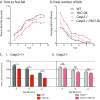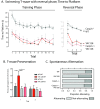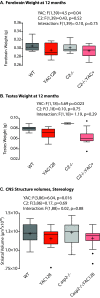Mice lacking caspase-2 are protected from behavioral changes, but not pathology, in the YAC128 model of Huntington disease
- PMID: 21854568
- PMCID: PMC3180273
- DOI: 10.1186/1750-1326-6-59
Mice lacking caspase-2 are protected from behavioral changes, but not pathology, in the YAC128 model of Huntington disease
Abstract
Background: Huntington Disease (HD) is a neurodegenerative disorder in which caspase activation and cleavage of substrates, including the huntingtin protein, has been invoked as a pathological mechanism. Specific changes in caspase-2 (casp2) activity have been suggested to contribute to the pathogenesis of HD, however unique casp2 cleavage substrates have remained elusive. We thus utilized mice completely lacking casp2 (casp2-/-) to examine the role played by casp2 in the progression of HD. This 'substrate agnostic' approach allows us to query the effect of casp2 on HD progression without pre-defining proteolytic substrates of interest.
Results: YAC128 HD model mice lacking casp2 show protection from well-validated motor and cognitive features of HD, including performance on rotarod, swimming T-maze, pre-pulse inhibition, spontaneous alternation and locomotor tasks. However, the specific pathological features of the YAC128 mice including striatal volume loss and testicular degeneration are unaltered in mice lacking casp2. The application of high-resolution magnetic resonance imaging (MRI) techniques validates specific neuropathology in the YAC128 mice that is not altered by ablation of casp2.
Conclusions: The rescue of behavioral phenotypes in the absence of pathological improvement suggests that different pathways may be operative in the dysfunction of neural circuitry in HD leading to behavioral changes compared to the processes leading to cell death and volume loss. Inhibition of caspase-2 activity may be associated with symptomatic improvement in HD.
Figures






Similar articles
-
YAC128 mouse model of Huntington disease is protected against subtle chronic manganese (Mn)-induced behavioral and neuropathological changes.Neurotoxicology. 2021 Dec;87:94-105. doi: 10.1016/j.neuro.2021.09.002. Epub 2021 Sep 17. Neurotoxicology. 2021. PMID: 34543681 Free PMC article.
-
Cognitive dysfunction precedes neuropathology and motor abnormalities in the YAC128 mouse model of Huntington's disease.J Neurosci. 2005 Apr 20;25(16):4169-80. doi: 10.1523/JNEUROSCI.0590-05.2005. J Neurosci. 2005. PMID: 15843620 Free PMC article.
-
Loss of wild-type huntingtin influences motor dysfunction and survival in the YAC128 mouse model of Huntington disease.Hum Mol Genet. 2005 May 15;14(10):1379-92. doi: 10.1093/hmg/ddi147. Epub 2005 Apr 13. Hum Mol Genet. 2005. PMID: 15829505
-
Partial rescue of some features of Huntington Disease in the genetic absence of caspase-6 in YAC128 mice.Neurobiol Dis. 2015 Apr;76:24-36. doi: 10.1016/j.nbd.2014.12.030. Epub 2015 Jan 9. Neurobiol Dis. 2015. PMID: 25583186
-
Screening of therapeutic strategies for Huntington's disease in YAC128 transgenic mice.CNS Neurosci Ther. 2012 Jan;18(1):77-86. doi: 10.1111/j.1755-5949.2011.00246.x. CNS Neurosci Ther. 2012. PMID: 21501423 Free PMC article. Review.
Cited by
-
Caspase-2 promotes AMPA receptor internalization and cognitive flexibility via mTORC2-AKT-GSK3β signaling.Nat Commun. 2019 Aug 9;10(1):3622. doi: 10.1038/s41467-019-11575-1. Nat Commun. 2019. PMID: 31399584 Free PMC article.
-
ER stress induces caspase-2-tBID-GSDME-dependent cell death in neurons lytically infected with herpes simplex virus type 2.EMBO J. 2023 Oct 4;42(19):e113118. doi: 10.15252/embj.2022113118. Epub 2023 Aug 30. EMBO J. 2023. PMID: 37646198 Free PMC article.
-
Uncovering the PIDDosome and caspase-2 as regulators of organogenesis and cellular differentiation.Cell Death Differ. 2020 Jul;27(7):2037-2047. doi: 10.1038/s41418-020-0556-6. Epub 2020 May 15. Cell Death Differ. 2020. PMID: 32415279 Free PMC article. Review.
-
The Accumulation of Tau in Postsynaptic Structures: A Common Feature in Multiple Neurodegenerative Diseases?Neuroscientist. 2020 Oct-Dec;26(5-6):503-520. doi: 10.1177/1073858420916696. Epub 2020 May 9. Neuroscientist. 2020. PMID: 32389059 Free PMC article. Review.
-
Mitochondrial Bioenergy in Neurodegenerative Disease: Huntington and Parkinson.Int J Mol Sci. 2023 Apr 13;24(8):7221. doi: 10.3390/ijms24087221. Int J Mol Sci. 2023. PMID: 37108382 Free PMC article. Review.
References
Grants and funding
LinkOut - more resources
Full Text Sources
Other Literature Sources

